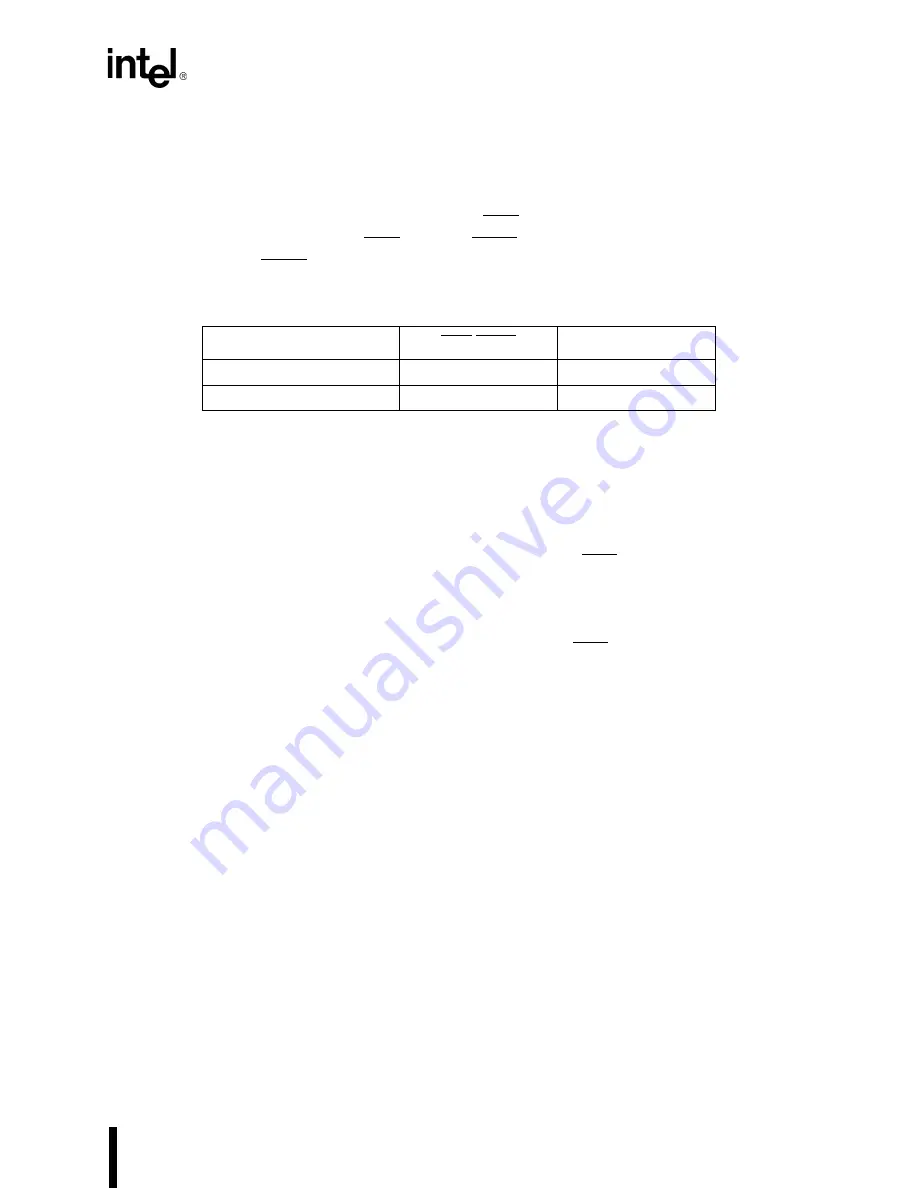
7-5
REFRESH CONTROL UNIT
7.5
REFRESH BUS CYCLES
Refresh bus cycles look exactly like ordinary memory read bus cycles except for the control sig-
nals listed in Table 7-1. These signals can be ANDed in a DRAM controller to detect a refresh
bus cycle. The 16-bit bus processor drives both the BHE and A0 pins high during refresh cycles.
The 8-bit bus version replaces the BHE pin with RFSH, which has the same timings. The 8-bit
bus processor drives RFSH low and A0 high during refresh cycles.
7.6
GUIDELINES FOR DESIGNING DRAM CONTROLLERS
The basic DRAM access method consists of four phases:
1.
The DRAM controller supplies a row address to the DRAMs.
2.
The DRAM controller asserts a Row Address Strobe (RAS), which latches the row
address inside the DRAMs.
3.
The DRAM controller supplies a column address to the DRAMs.
4.
The DRAM controller asserts a Column Address Strobe (CAS), which latches the column
address inside the DRAMs.
Most 80C186 Modular Core family DRAM interfaces use only this method. Others are not dis-
cussed here.
The DRAM controller’s purpose is to use the processor’s address, status and control lines to gen-
erate the multiplexed addresses and strobes. These signals must be appropriate for three bus cycle
types: read, write and refresh. They must also meet specific pulse width, setup and hold timing
requirements. DRAM interface designs need special attention to transmission line effects, since
DRAMs represent significant loads on the bus.
DRAM controllers may be either clocked or unclocked. An unclocked DRAM controller requires
a tapped digital delay line to derive the proper timings.
Clocked DRAM controllers may use either discrete or programmable logic devices. A state ma-
chine design is appropriate, especially if the circuit must provide wait state control (beyond that
possible with the processor’s Chip-Select Unit). Because of the microprocessor’s four-clock bus,
clocking some logic elements on each CLKOUT phase is advantageous (see Figure 7-4).
Table 7-1. Identification of Refresh Bus Cycles
Data Bus Width
BHE/RFSH
A0
16-Bit Device
1
1
8-Bit Device
0
1
Summary of Contents for 80C186XL
Page 1: ...80C186XL 80C188XL Microprocessor User s Manual...
Page 2: ...80C186XL 80C188XL Microprocessor User s Manual 1995...
Page 18: ...1 Introduction...
Page 19: ......
Page 27: ......
Page 28: ...2 Overview of the 80C186 Family Architecture...
Page 29: ......
Page 79: ......
Page 80: ...3 Bus Interface Unit...
Page 81: ......
Page 127: ......
Page 128: ...4 Peripheral Control Block...
Page 129: ......
Page 137: ......
Page 138: ...5 ClockGenerationand Power Management...
Page 139: ......
Page 154: ...6 Chip Select Unit...
Page 155: ......
Page 178: ...7 Refresh Control Unit...
Page 179: ......
Page 193: ......
Page 194: ...8 Interrupt Control Unit...
Page 195: ......
Page 227: ......
Page 228: ...9 Timer Counter Unit...
Page 229: ......
Page 253: ......
Page 254: ...10 Direct Memory Access Unit...
Page 255: ......
Page 283: ......
Page 284: ...11 Math Coprocessing...
Page 285: ......
Page 302: ...12 ONCE Mode...
Page 303: ......
Page 306: ...A 80C186 Instruction Set Additions and Extensions...
Page 307: ......
Page 318: ...B Input Synchronization...
Page 319: ......
Page 322: ...C Instruction Set Descriptions...
Page 323: ......
Page 371: ......
Page 372: ...D Instruction Set Opcodes and Clock Cycles...
Page 373: ......
Page 396: ...Index...
Page 397: ......















































